Investigation of Natural Weak Interface Properties and Their Impact on Fracture Propagation in Shale Reservoirs
Abstract
:1. Introduction
2. Shale Mechanical Parameter Tests
2.1. Sampling and Processing of Natural Outcropping Shale
2.2. Test Equipment
2.3. Experiment Method
2.4. Experiment Data Processing
3. Mathematical Physics Equations
3.1. Cohesive Unit Damage Model
3.2. Fluid Flow within Fractures
3.3. Interaction Settings between HF and NF
3.4. Wellbore Fluid Flow Equation
3.4.1. Perforation Friction
3.4.2. Wellbore Flow Friction
4. Numerical Model
4.1. Three-Dimensional Finite Element Model
4.2. Model Validation
5. Results
5.1. NF Bond Strength
5.2. Perforation Density
5.3. Injection Rate
5.4. Fracturing Fluid Viscosity
6. Conclusions
- (1)
- Reservoir stress difference is a key parameter that influences the interactive expansion pattern of hydraulic fractures (HFs) and natural fractures (NFs). The magnitude of horizontal principal stress dominates the formation mode and geometric shape of complex fracture networks. Greater stress difference leads to a stronger ability of HFs to open natural fracture surfaces and a more pronounced shear-sliding along the weak interfaces. Conversely, HFs will propagate through the natural fracture surfaces in the direction of fracture height when the stress difference is smaller.
- (2)
- Only when the cohesive strength of NFs is lower than the strength of the rock matrix can NF interfaces be initiated. Higher cohesive strength results in HFs showing no significant passivation phenomenon on natural fracture surfaces and enhances their ability to penetrate through the natural fracture surfaces. On the other hand, lower cohesive strength makes HFs more prone to passivation, leading to shear failure of NFs. Consequently, HFs open up and redirect along NFs for further expansion.
- (3)
- The combination of perforation density is a significant factor contributing to inter-cluster stress interference. A higher density of boreholes and a larger number of clusters result in an increased stress shadow area. Consequently, the ability of fluid penetration within the shadow region of perforation clusters weakens, leading to the ineffectiveness of intermediate cluster HF2 in forming fractures. When the perforation frictional resistance reaches a certain threshold, the dynamic allocation of fluid flow among multiple fractures shifts from being governed by inter-cluster shadows to the magnitude of perforation frictional resistance. Strategically arranging a lower pore density and fewer boreholes effectively increases pore resistance, alleviates inter-cluster stress interference, and promotes the balanced development of multiple fractures.
- (4)
- Increasing the injection rate and viscosity of the fracturing fluid facilitates the propagation of all perforation clusters within the fractures, thereby enhancing the likelihood of opening natural fractures (NFs). As the injection rate and fracturing fluid viscosity increase, there is a notable increase in shear displacement along the natural fracture surfaces, which promotes the development of complex fractures in reservoirs. However, both factors have a threshold beyond which they fail to effectively improve reservoir stimulation.
Author Contributions
Funding
Institutional Review Board Statement
Informed Consent Statement
Data Availability Statement
Conflicts of Interest
References
- Zou, C.N.; Dong, D.Z.; Wang, S.J.; Li, J.Z.; Li, X.J.; Wang, Y.M.; Li, D.H.; Cheng, K.M. Formation mechanism, geological characteristics and resource potential of Shale gas in China. Pet. Explor. Dev. 2010, 37, 641–653. [Google Scholar] [CrossRef]
- Zou, C.N.; Pan, S.Q.; Jing, Z.H.; Gao, J.L.; Yang, Z.; Wu, S.T.; Zhao, Q. Shale oil and gas revolution and its impact. Acta Pet. Sin. 2020, 41, 1. [Google Scholar]
- Zou, C.N.; Zhu, R.K.; Dong, D.Z.; Wu, S.T. Scientific and technological progress, development strategy and policy suggestion regarding shale oil and gas. Acta Pet. Sin. 2022, 43, 1675–1686. [Google Scholar]
- Chen, Z.; Bunger, A.; Zhang, X.; Jeffrey, R.G. Cohesive zone finite element-based modeling of hydraulic fractures. Acta Mech. Solida Sin. 2009, 22, 443–452. [Google Scholar] [CrossRef]
- Wang, W.; Zhang, K.; Su, Y.; Tang, M.; Zhang, Q.; Sheng, G. Fracture Network Mapping Using Integrated Micro-Seismic Events Inverse with Rate-Transient Analysis. In Proceedings of the 11th International Petroleum Technology Conference, Beijing, China, 26–28 March 2019. [Google Scholar]
- Warpinski, N.R.; Teufel, L.W. Influence of Geologic Discontinuities on Hydraulic Fracture Propagation. J. Pet. Technol. 1987, 39, 209–220. [Google Scholar] [CrossRef]
- Zhou, J.; Chen, M.; Jing, Y.; Zhang, G.Q. Experimental study on propagation mechanism of hydraulic fracture in naturallyfractured reservoir. Acta Pet. Sin. 2007, 28, 109–113. [Google Scholar]
- Blanton, T.L. An Experimental Study of Interaction between Hydraulically Induced and Pre-Existing Fractures. In Proceedings of the SPE Unconventional Gas Recovery Symposium, Pittsburgh, PA, USA, 16–18 May 1982; p. SPE-10847-MS. [Google Scholar]
- Yushi, Z.; Shicheng, Z.; Tong, Z.; Xiang, Z.; Tiankui, G. Experimental Investigation into Hydraulic Fracture Network Propagation in Gas Shales Using CT Scanning Technology. Rock Mech. Rock Eng. 2016, 49, 33–45. [Google Scholar] [CrossRef]
- Guo, J.; Zhao, X.; Zhu, H.; Zhang, X.; Pan, R. Numerical simulation of interaction of hydraulic fracture and natural fracture based on the cohesive zone finite element method. J. Nat. Gas Sci. Engng. 2015, 25, 180–188. [Google Scholar] [CrossRef]
- Gonzalez-Chavez, M.; Dahi Taleghani, A.; Olson, J.E. A cohesive model for modeling hydraulic fractures in naturally fractured formations. In Proceedings of the SPE Hydraulic Fracturing Technology Conference, The Woodlands, TX, USA, 3–5 February 2015. [Google Scholar]
- De Pater, C.J.; Beugelsdijk, L.J.L. Experiments and numerical simulation of hy-draulic fracturing in naturally fractured rock, Alaska Rocks 2005. In Proceedings of the 40th U.S. Symposium on Rock Mechanics (USRMS), Anchorage, AK, USA, 25–29 June 2005; American Rock Mechanics Association: Anchorage, AK, USA, 2005. [Google Scholar]
- Nagel, N.B.; Gil, I.; Sanchez-Nagel, M.; Damjanac, B. Simulating hydraulic frac-turing in real fractured rock-overcoming the limits of pseudo-3D models. In Proceedings of the SPE Hydraulic Fracturing Technology Conference, The Woodlands, TX, USA, 24–26 January 2011; Society of Petroleum Engineers: The Woodlands, TX, USA, 2011. [Google Scholar]
- Zou, Y.S.; Zhang, S.C.; Ma, X.F.; Zhou, T.; Zeng, B. Numerical investigation of hydraulic fracture network propagation in naturally fractured shale formations. J. Struct. Geol. 2016, 84, 1–13. [Google Scholar] [CrossRef]
- Roussel, N.P.; Sharma, M.M. Optimizing Fracture Spacing and Sequencing in Horizontal-Well Fracturing. SPE Prod. Oper. 2011, 26, 173–184. [Google Scholar] [CrossRef]
- Manchanda, R.; Sharma, M.M.; Holzhauser, S. Time-dependent fracture-interference effects in pad wells. SPE Prod. Oper. 2014, 29, 274–287. [Google Scholar] [CrossRef]
- Wu, R.; Kresse, O.; Weng, X. Modeling of interaction of hydraulic fractures in complex fracture networks. In Proceedings of the SPE Hydraulic Fracturing Technology Conference, The Woodlands, TX, USA, 6 February 2012. [Google Scholar]
- Anderson, T.L. Fracture Mechanics: Fundamentals and Applications; CRC Press: Boca Raton, FL, USA, 2017. [Google Scholar]
- Miao, Y.; Wei, C.H.; Niu, L.L.; Li, S.H.; Yu, Y.J. Calculation for tensile strength and fracture toughness of granite with three kinds of grain sizes using three-point-bending test. PloS ONE 2018, 13, 108413. [Google Scholar]
- Wu, K.; Olson, J.E. Mechanisms of Simultaneous Hydraulic-Fracture Propagation From Multiple Perforation Clusters in Horizontal Wells. SPE J. 2016, 21, 1000–1008. [Google Scholar] [CrossRef]
- El-Rabba, A.M.; Shah, S.N.; Lord, D.L. New Perforation Pressure-Loss Correlations for Limited-Entry Fracturing Treatments. SPE Prod. Facil. 1999, 14, 63–71. [Google Scholar] [CrossRef]
- Liu, X.; Qu, Z.; Guo, T.; Sun, Y.; Wang, Z.; Bakhshi, E. Numerical simulation of non-planar fracture propagation in multi-cluster fracturing with natural fractures based on Lattice methods. Eng. Fract. Mech. 2019, 220, 106625. [Google Scholar] [CrossRef]
- Zhou, J.; Chen, M.; Jin, Y.; Zhang, G.Q. Analysis of fracture propagation behavior and fracture geometry using a tri-axial fracturing system in naturally fractured reservoirs. Int. J. Rock Mech. Min. Sci. 2008, 45, 1143–1152. [Google Scholar] [CrossRef]
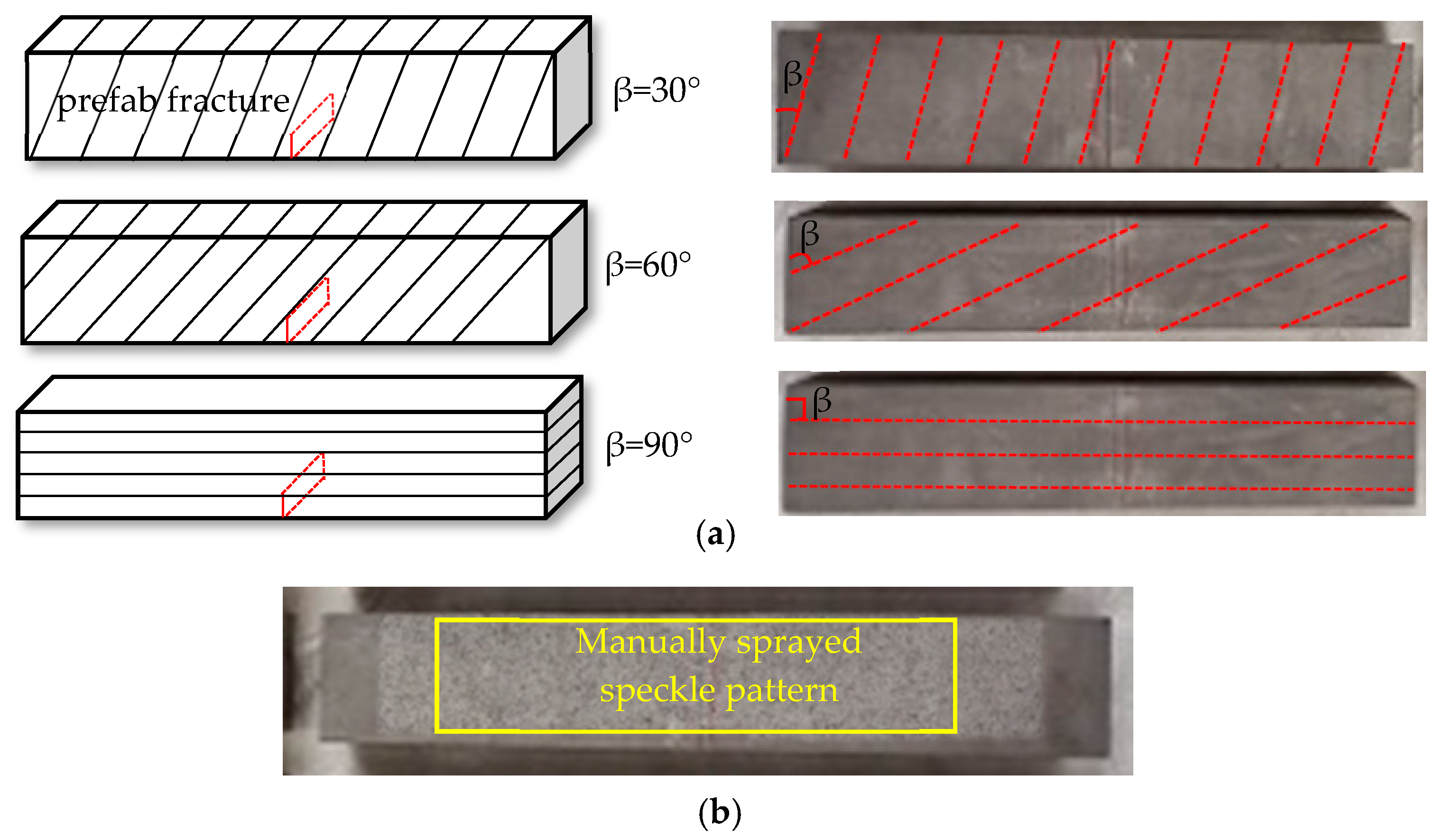
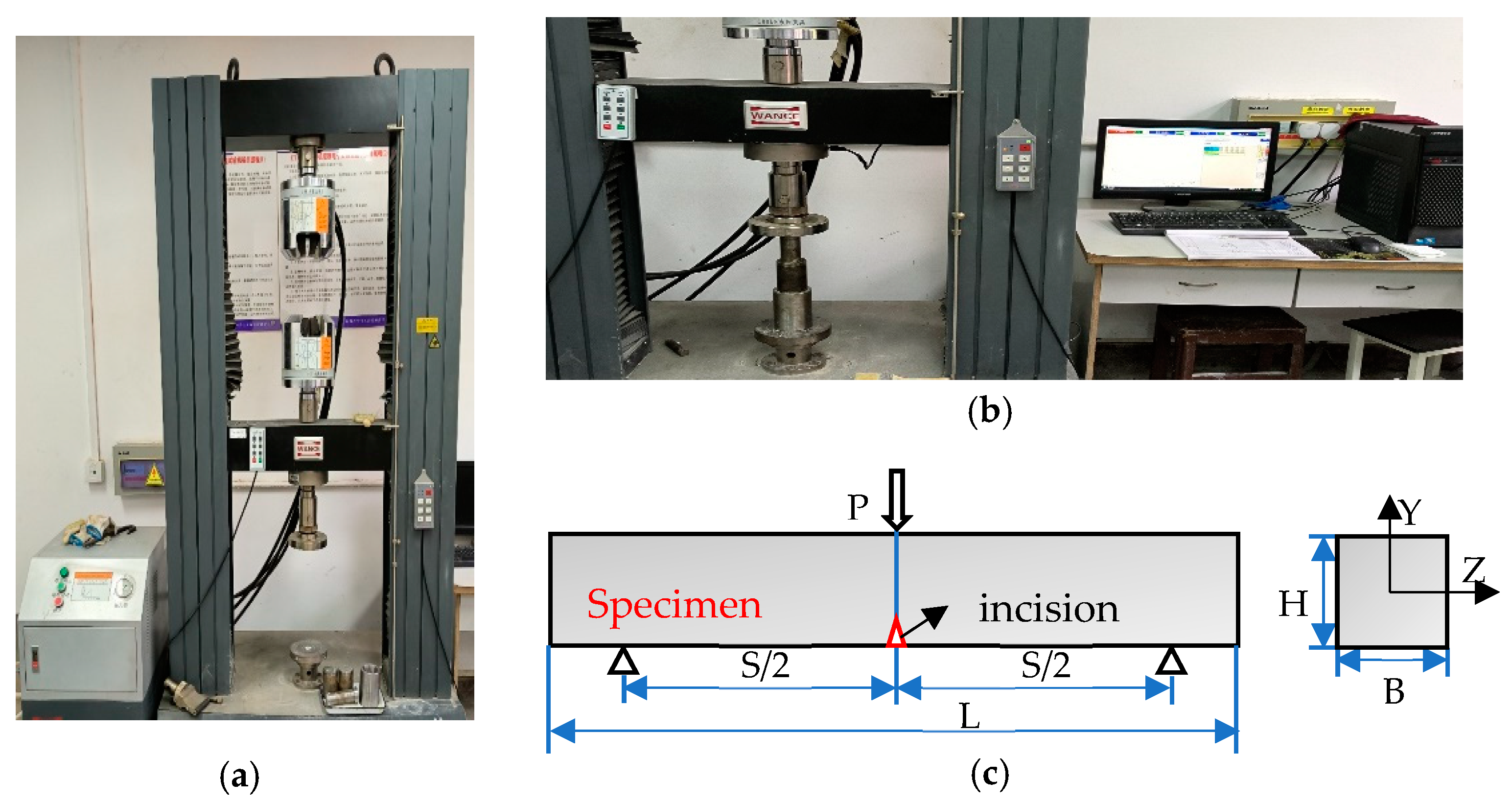
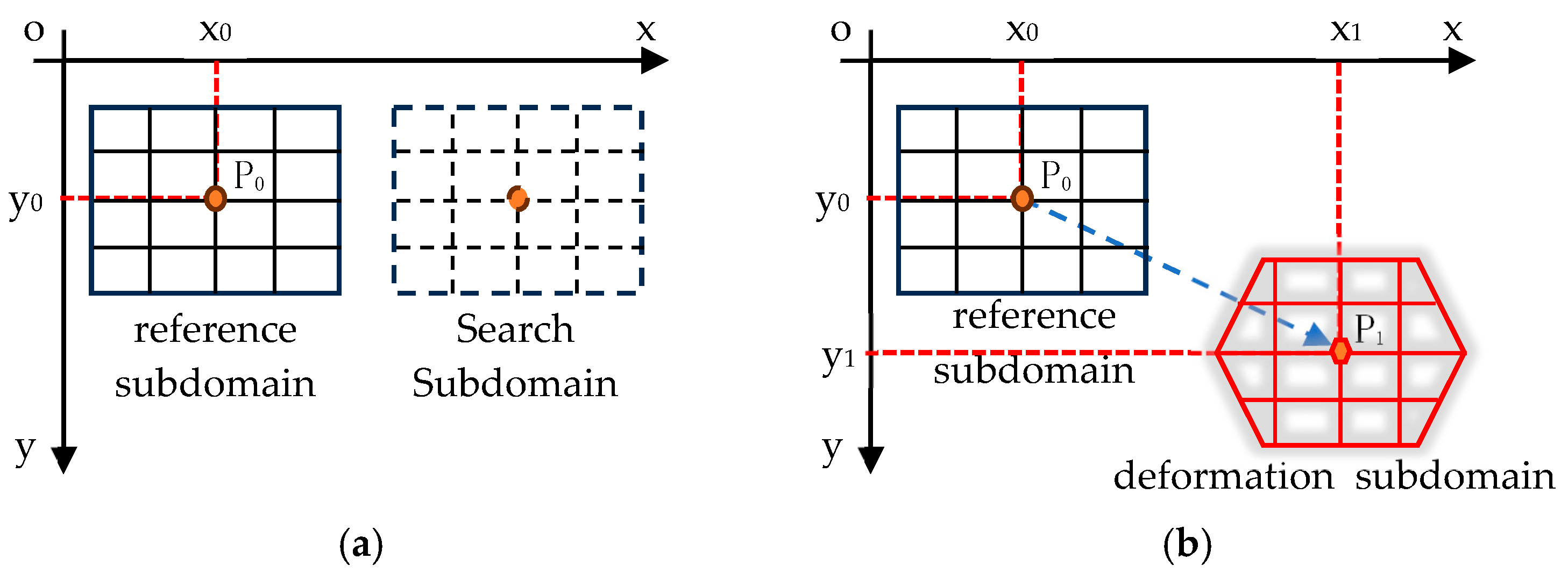
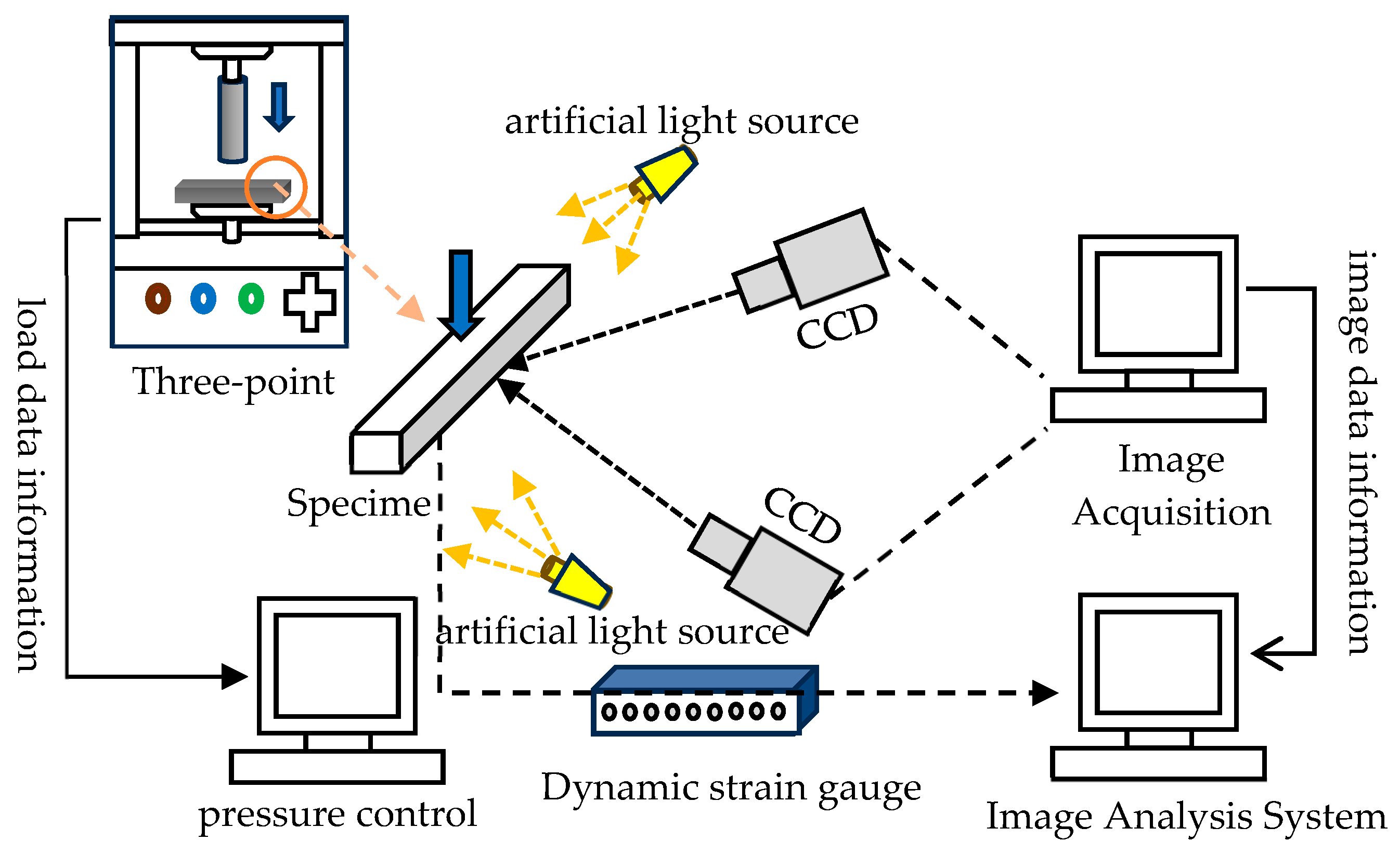





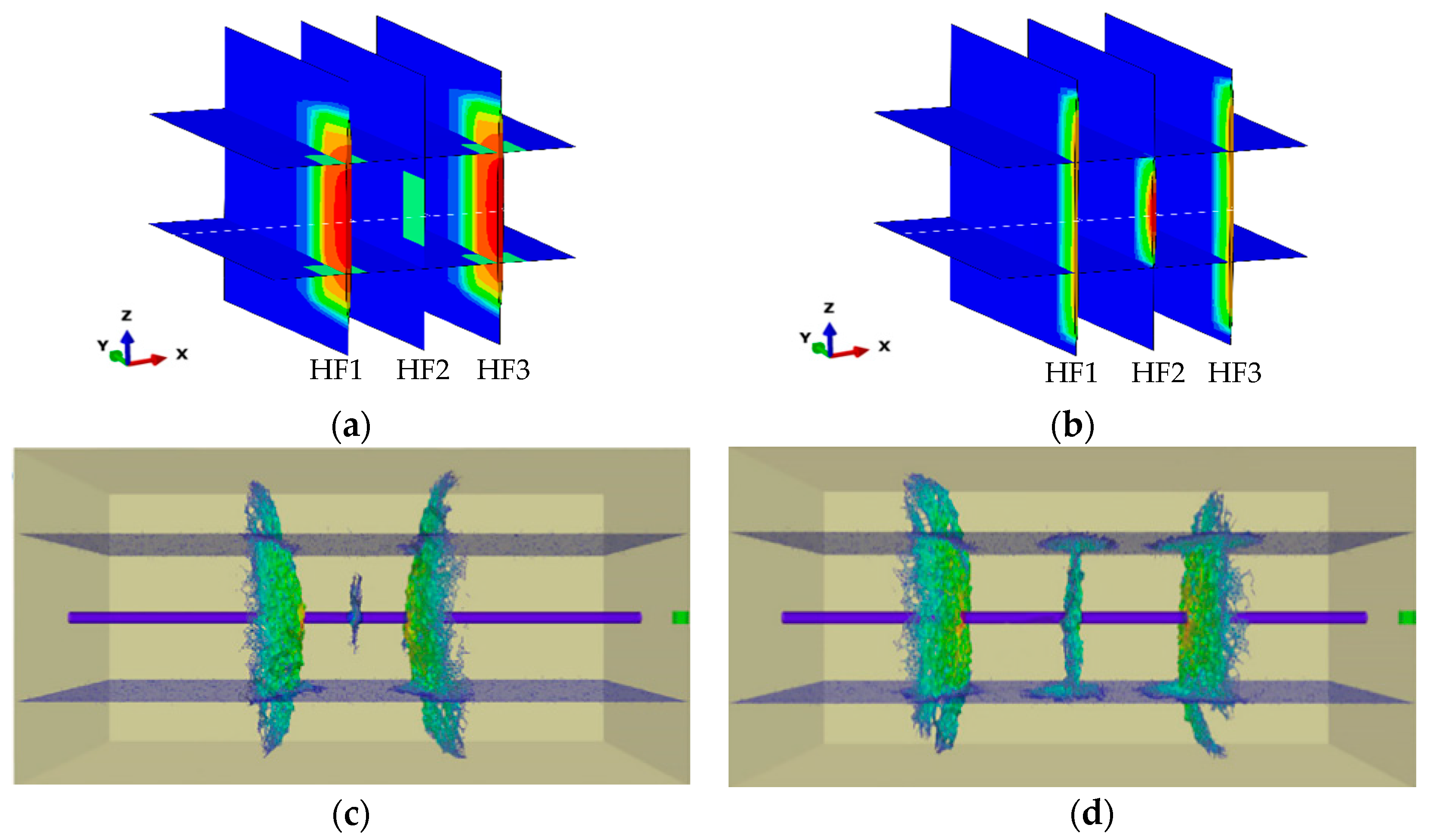
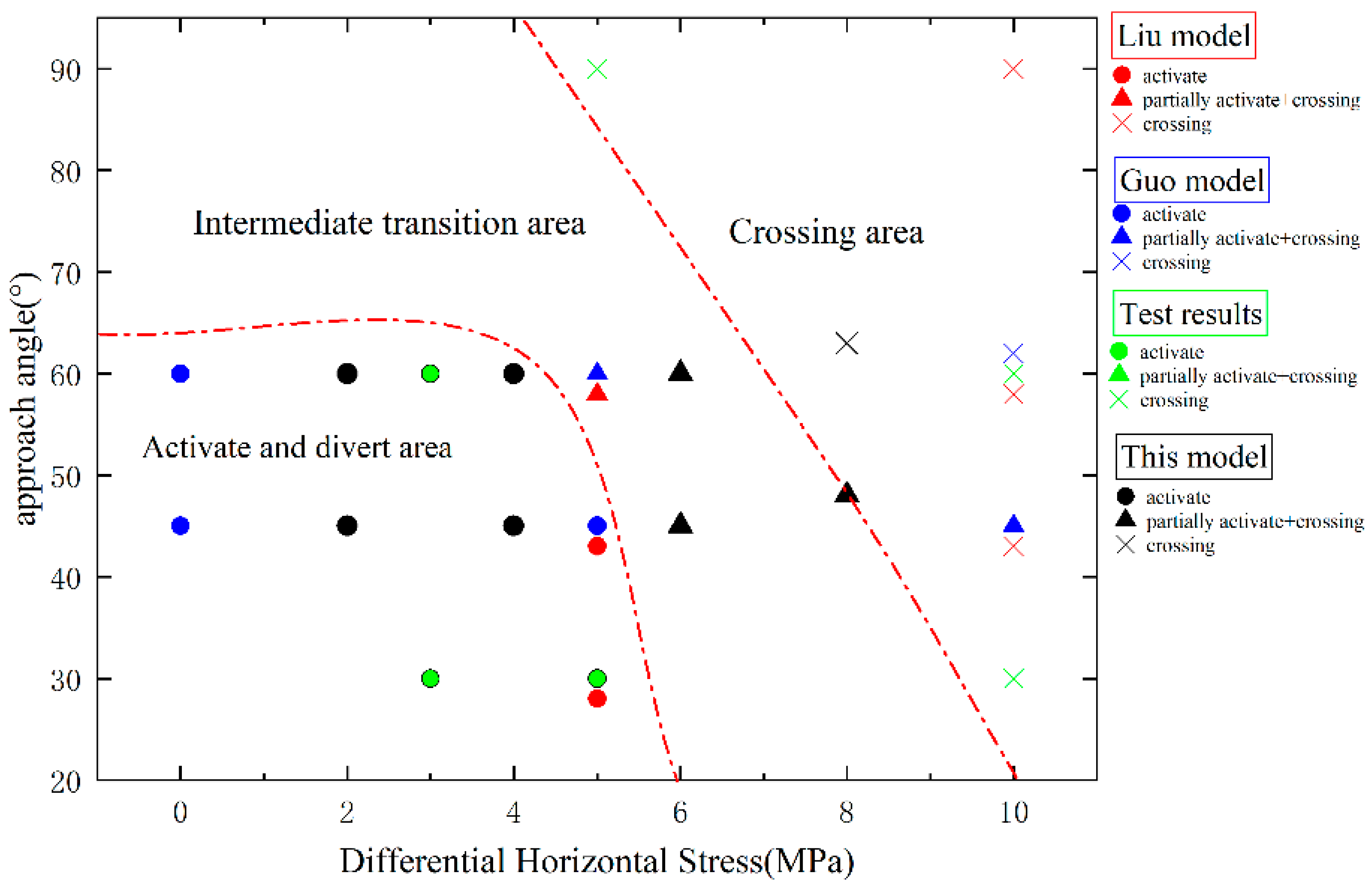
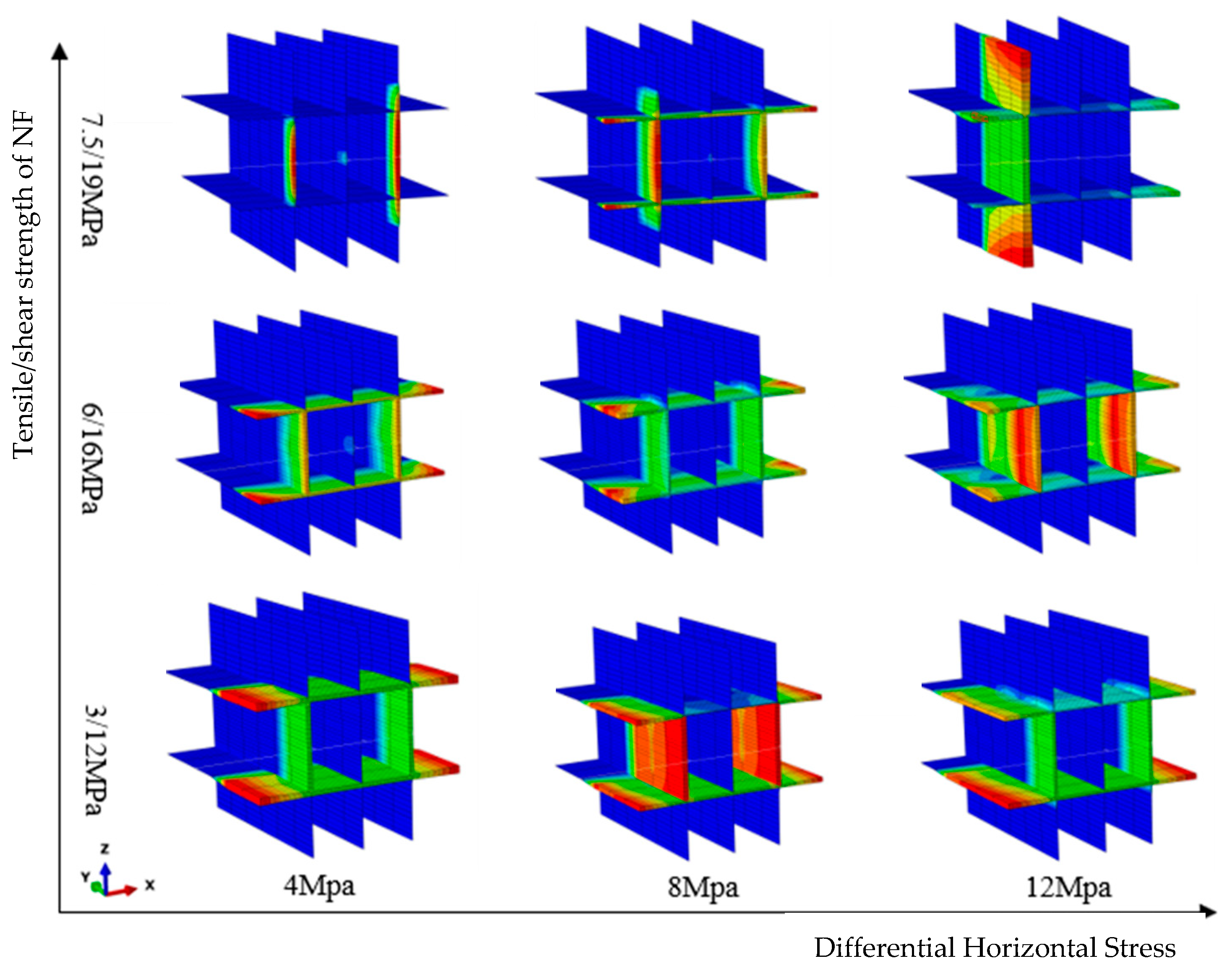
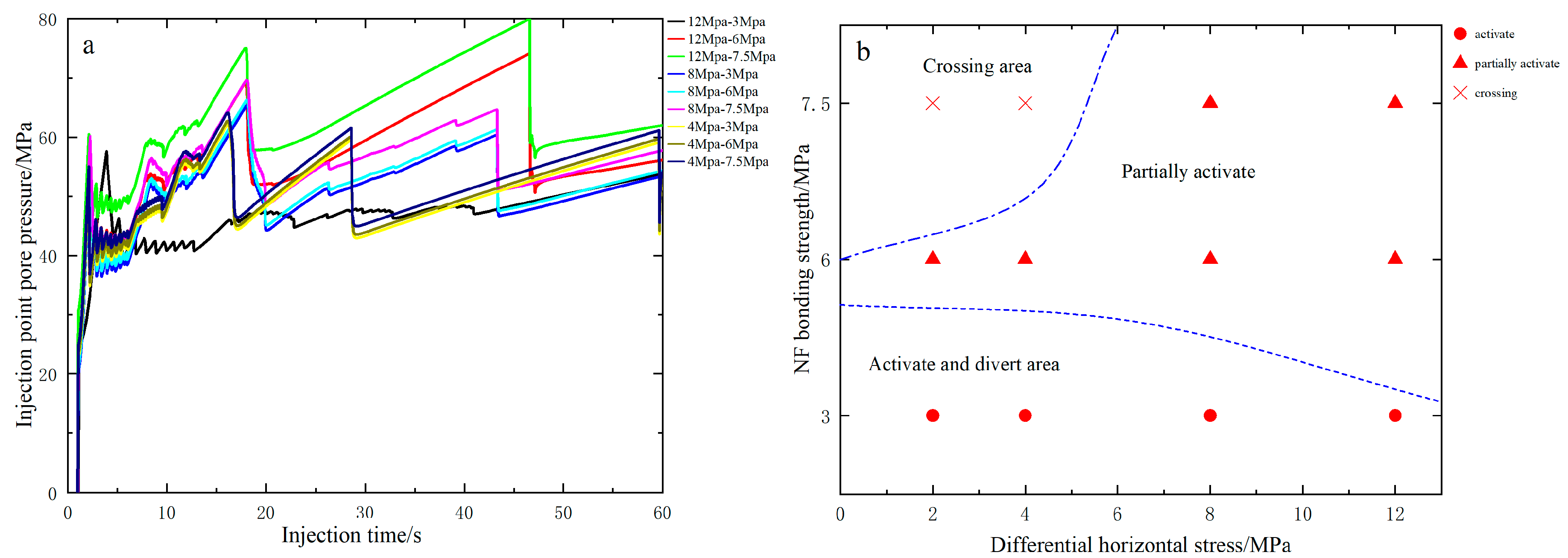
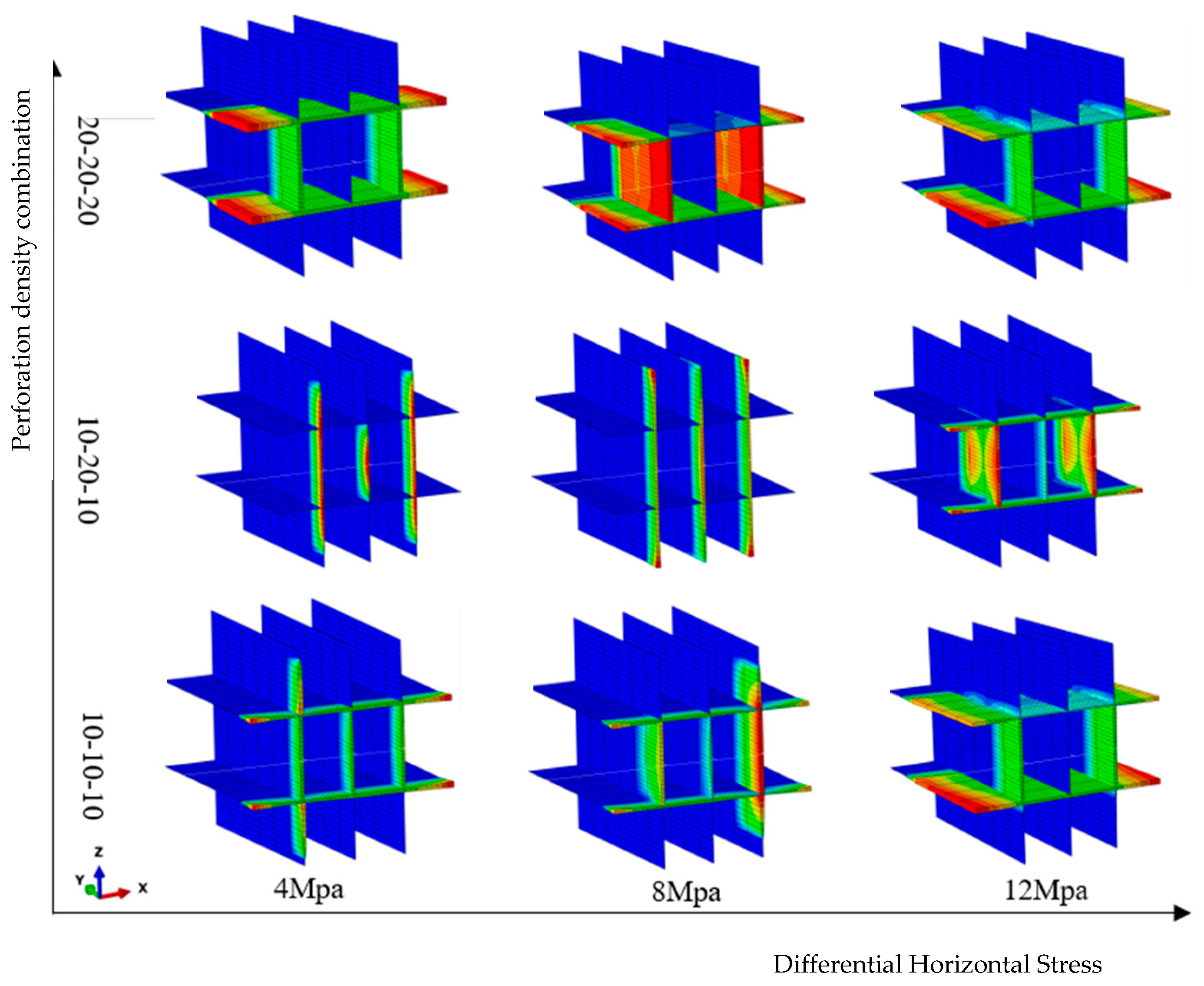
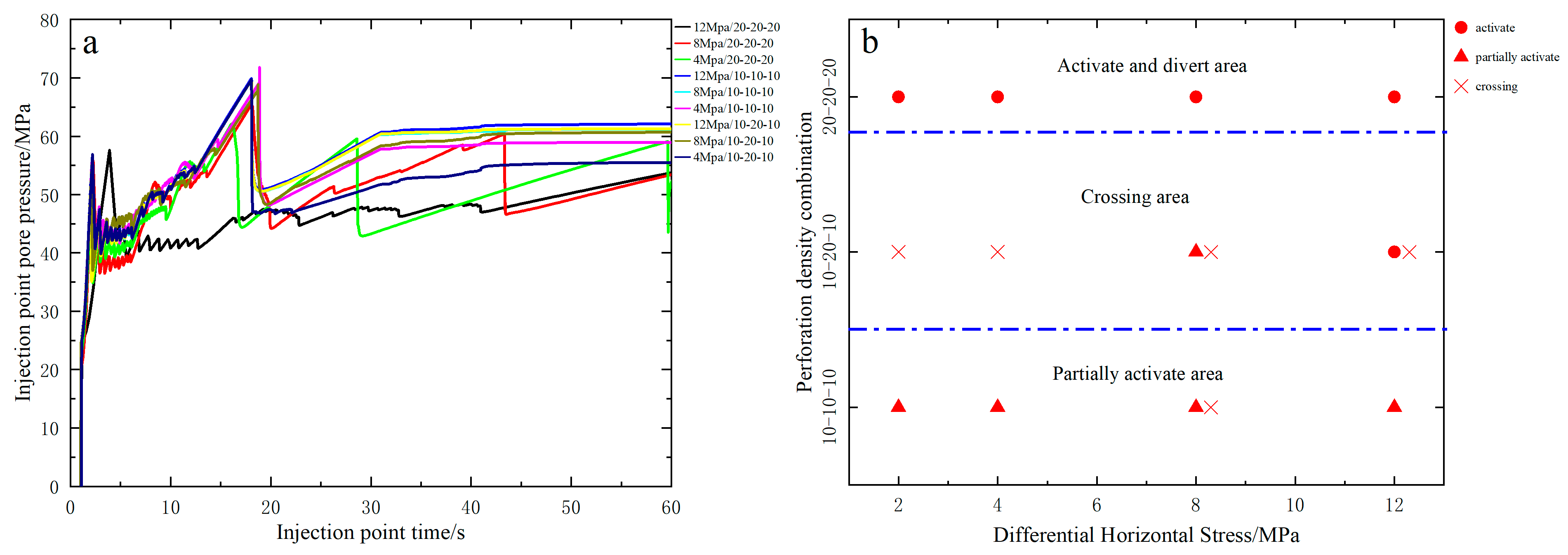
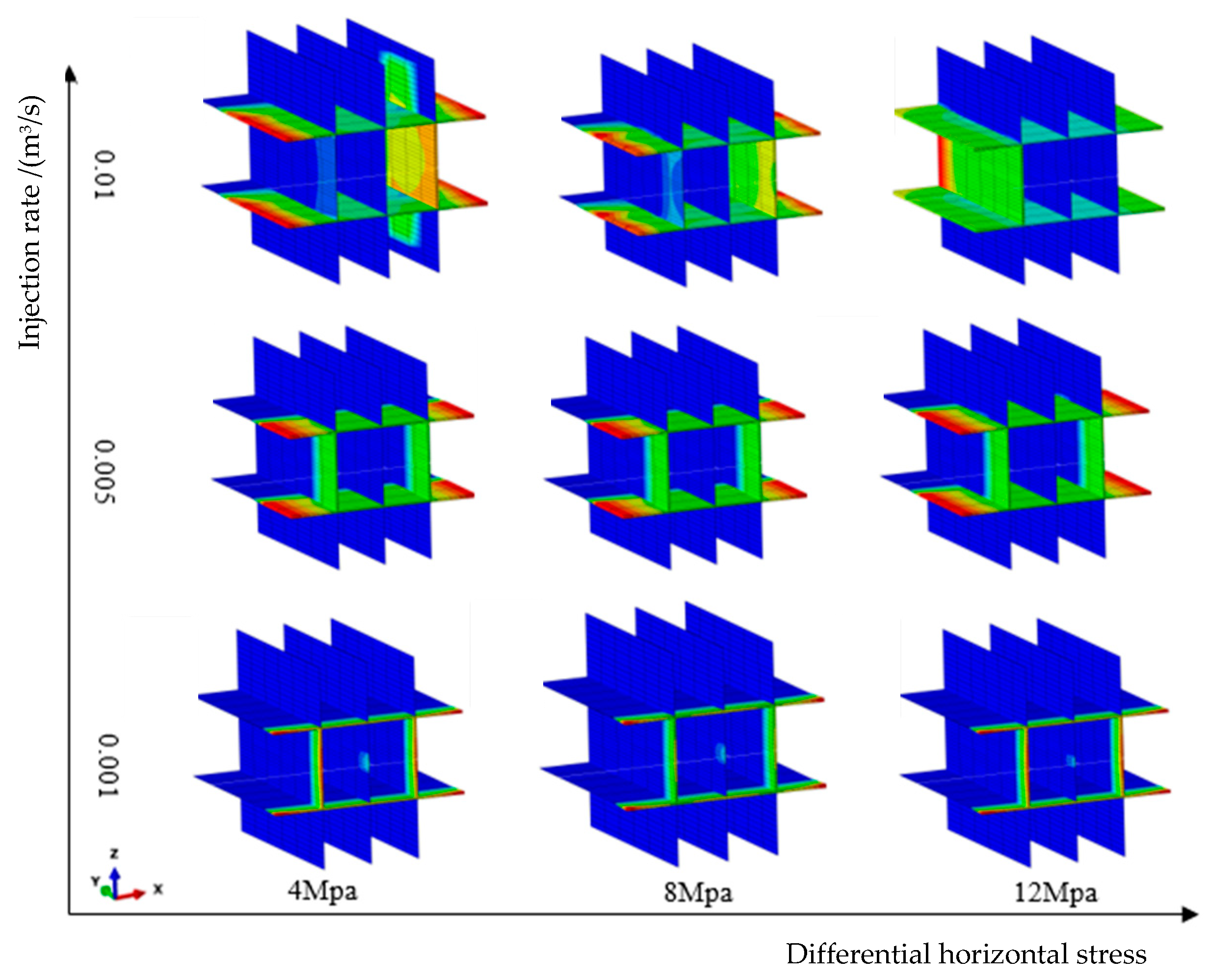
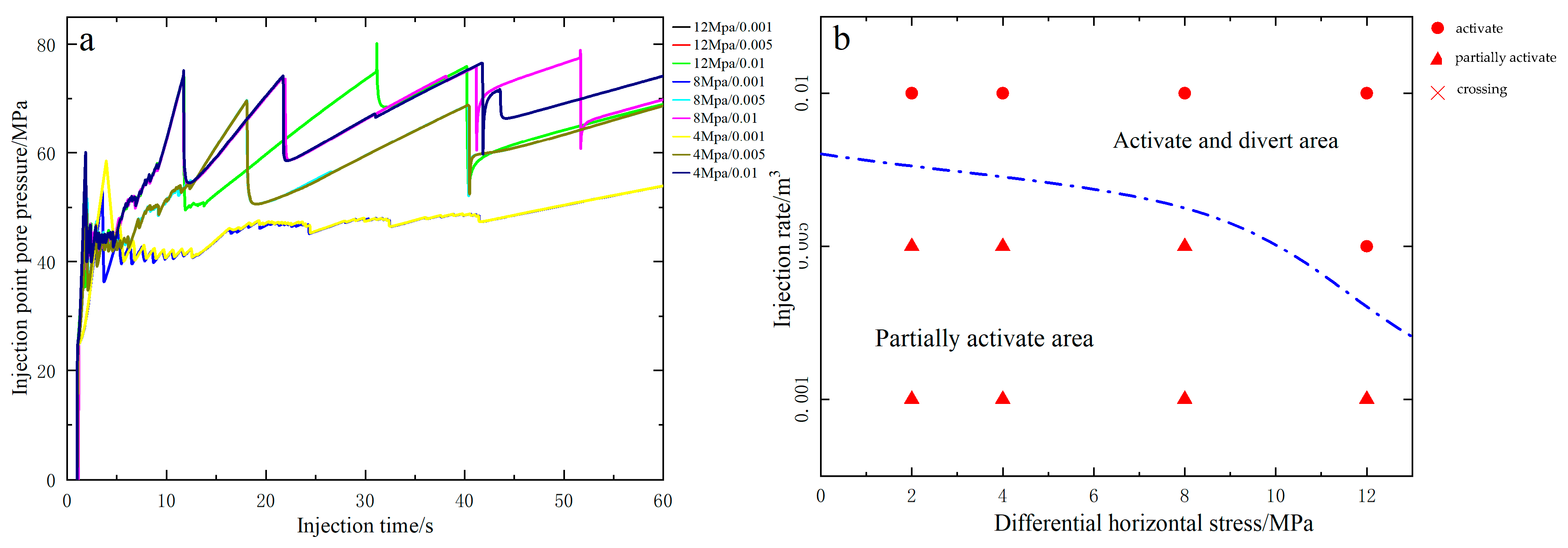
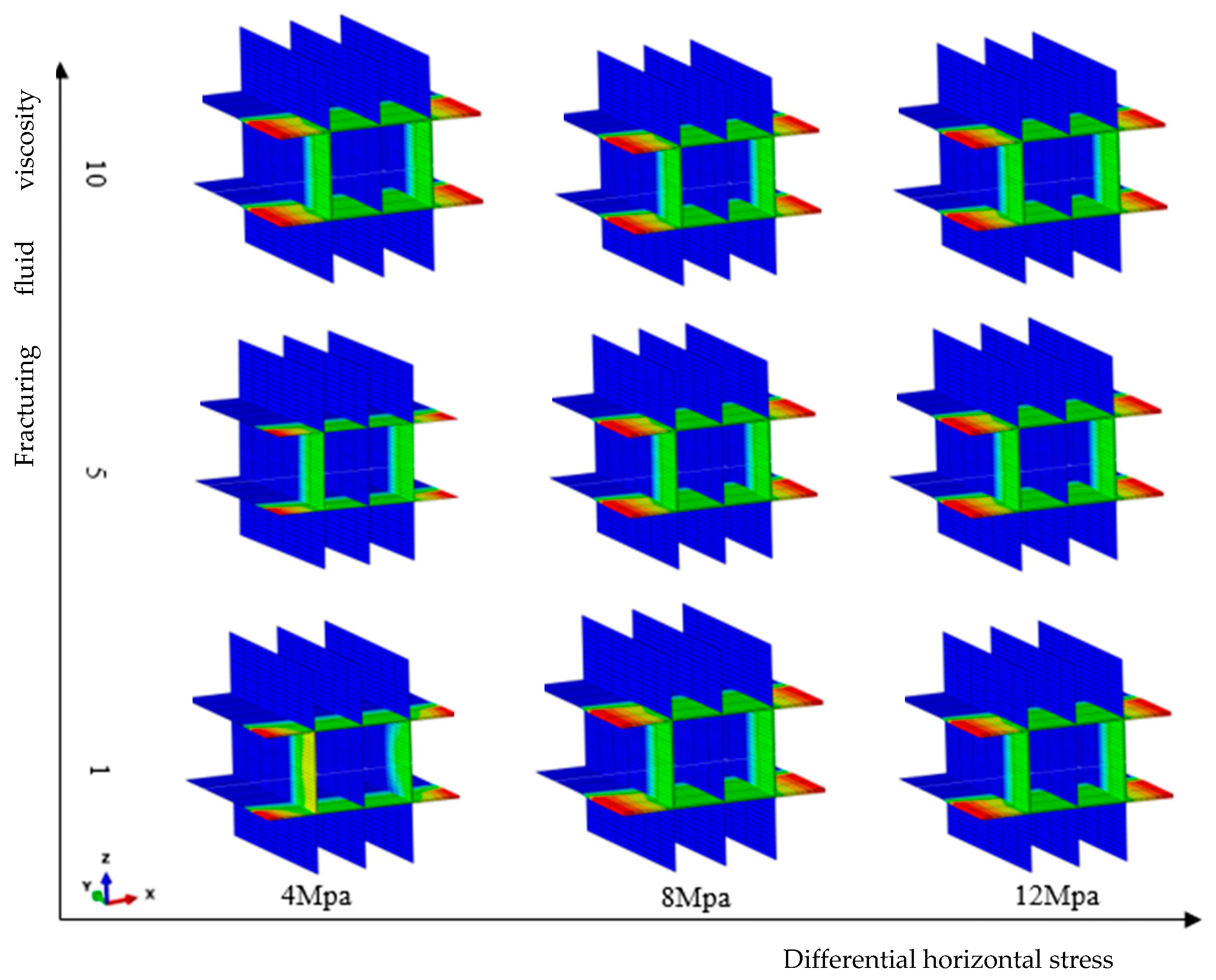

| Dip Angle of Natural Weak Planes | Specimen No. | Size | Amount |
|---|---|---|---|
| 30° | S30-1-1 | 250 × 50 × 50 mm | 4 |
| S30-1-2 | 250 × 50 × 50 mm | ||
| S30-1-3 | 250 × 50 × 50 mm | ||
| S30-1-4 | 250 × 50 × 50 mm | ||
| 60° | S60-1-1 | 250 × 50 × 50 mm | 4 |
| S60-1-2 | 250 × 50 × 50 mm | ||
| S60-1-3 | 250 × 50 × 50 mm | ||
| S60-1-4 | 250 × 50 × 50 mm | ||
| 90° | S90-1-1 | 250 × 50 × 50 mm | 4 |
| S90-1-2 | 250 × 50 × 50 mm | ||
| S90-1-3 | 250 × 50 × 50 mm | ||
| S90-1-4 | 250 × 50 × 50 mm |
| NF Dip | Specimen No. | Pmax (KN) | σmax(MPa) | KIC (MPa/m1/2) | Kσ (GPa/m) |
|---|---|---|---|---|---|
| 30° | S30-1 | 1.23 | 4.88 | 0.325 | 52.8 |
| S30-2 | 0.62 | 2.29 | 0.266 | 41.2 | |
| S30-3 | 1.14 | 4.27 | 0.317 | 51.6 | |
| S30-4 | 1.06 | 3.51 | 0.308 | 50.1 | |
| 60° | S60-1 | 1.25 | 5.02 | 0.328 | 53.2 |
| S60-2 | 1.35 | 5.24 | 0.332 | 53.7 | |
| S60-3 | 1.50 | 5.45 | 0.341 | 54.6 | |
| S60-4 | 1.57 | 5.84 | 0.345 | 54.9 | |
| 90° | S90-1 | 1.15 | 4.31 | 0.317 | 51.6 |
| S90-2 | 1.17 | 4.39 | 0.319 | 51.9 | |
| S90-3 | 1.18 | 4.43 | 0.319 | 51.9 | |
| S90-4 | 1.20 | 4.68 | 0.322 | 52.5 |
| Formation Parameters | Value | Construction Parameters | Value |
|---|---|---|---|
| Young’s modulus/GPa | 39 | Initial pore Pressure/MPa | 50 |
| Poisson’s ratio | 0.23 | Injection rate/m3·s−1 | 0.01 |
| In situ stress/MPa | 74.7/79.6/86.8 | Fracturing Fluid Viscosity/mPa·s | 5 |
| Permeability coefficient/m × s−1 | 1.5 × 10−8 | Clusters | 3 |
| Filter loss coefficient/m × Pas−1 (HF/NF)/(m·(Pas−1)) | 1 × 10−13/1 × 10−14 | Cluster spacing/m | 2.5 |
| tensile strength (HF/NF)/MPa | 8/3 | Perforation density combination | 20-20-20 |
| Shear strength (HF/NF)/MPa | 20/12 | Perforation hole diameter/m | 0.015 |
| Results | Approach Angle | Cluster Spacing | Interaction between HF and NF | Expansion Height (HF1–HF3) | Simulation Error |
|---|---|---|---|---|---|
| this model | 90° | 2 m | HF1 and HF2 are penetrated HF3 is an invalid fracture | 9.5 m, 0 m, 9.5 m | 3.15% |
| Liu model | 9.2 m, 0.5 m, 9.3 m | ||||
| this model | 90° | 3 m | HF1 and HF2 are penetrated HF3 is intercepted and diverted | 9.6 m, 4.8 m, 9.6 m | 2.04% |
| Liu model | 9.8 m, 4.6 m, 9.7 m |
Disclaimer/Publisher’s Note: The statements, opinions and data contained in all publications are solely those of the individual author(s) and contributor(s) and not of MDPI and/or the editor(s). MDPI and/or the editor(s) disclaim responsibility for any injury to people or property resulting from any ideas, methods, instructions or products referred to in the content. |
© 2023 by the authors. Licensee MDPI, Basel, Switzerland. This article is an open access article distributed under the terms and conditions of the Creative Commons Attribution (CC BY) license (https://creativecommons.org/licenses/by/4.0/).
Share and Cite
Chen, Q.; Huang, Z.; Ling, X.; Xu, P.; Tu, L.; Liao, W.; Xie, J.; Wang, M.; Chen, Y.; Li, L. Investigation of Natural Weak Interface Properties and Their Impact on Fracture Propagation in Shale Reservoirs. Processes 2023, 11, 2697. https://doi.org/10.3390/pr11092697
Chen Q, Huang Z, Ling X, Xu P, Tu L, Liao W, Xie J, Wang M, Chen Y, Li L. Investigation of Natural Weak Interface Properties and Their Impact on Fracture Propagation in Shale Reservoirs. Processes. 2023; 11(9):2697. https://doi.org/10.3390/pr11092697
Chicago/Turabian StyleChen, Qi, Zhiqiang Huang, Xingjie Ling, Pengju Xu, Lanke Tu, Wenjing Liao, Jun Xie, Meng Wang, Yijing Chen, and Lingli Li. 2023. "Investigation of Natural Weak Interface Properties and Their Impact on Fracture Propagation in Shale Reservoirs" Processes 11, no. 9: 2697. https://doi.org/10.3390/pr11092697
APA StyleChen, Q., Huang, Z., Ling, X., Xu, P., Tu, L., Liao, W., Xie, J., Wang, M., Chen, Y., & Li, L. (2023). Investigation of Natural Weak Interface Properties and Their Impact on Fracture Propagation in Shale Reservoirs. Processes, 11(9), 2697. https://doi.org/10.3390/pr11092697








